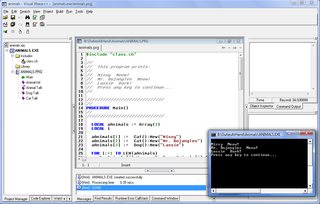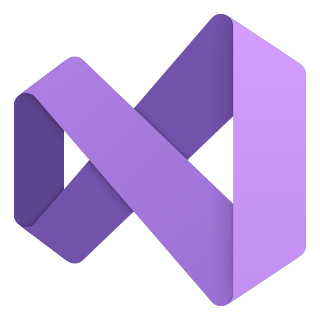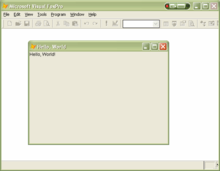
Microsoft Access is a database management system (DBMS) from Microsoft that combines the relational Access Database Engine (ACE) with a graphical user interface and software-development tools. It is a member of the Microsoft 365 suite of applications, included in the Professional and higher editions or sold separately.
dBase was one of the first database management systems for microcomputers and the most successful in its day. The dBase system included the core database engine, a query system, a forms engine, and a programming language that tied all of these components together.

FreeBASIC is a free and open source multiplatform compiler and programming language based on BASIC licensed under the GNU GPL for Microsoft Windows, protected-mode MS-DOS, Linux, FreeBSD and Xbox. The Xbox version is no longer maintained.
xHarbour is a free multi-platform extended Clipper compiler, offering multiple graphic terminals (GTs), including console drivers, GUIs, and hybrid console/GUIs. xHarbour is backward-compatible with Clipper and supports many language syntax extensions, greatly extended run-time libraries, and extensive third party support.
Harbour is a computer programming language, primarily used to create database/business programs. It is a modernised, open source and cross-platform version of the older Clipper system, which in turn developed from the dBase database market of the 1980s and 1990s.
The Access Database Engine is a database engine on which several Microsoft products have been built. The first version of Jet was developed in 1992, consisting of three modules which could be used to manipulate a database.

Microsoft Data Access Components is a framework of interrelated Microsoft technologies that allows programmers a uniform and comprehensive way of developing applications that can access almost any data store. Its components include: ActiveX Data Objects (ADO), OLE DB, and Open Database Connectivity (ODBC). There have been several deprecated components as well, such as the Jet Database Engine, MSDASQL, and Remote Data Services (RDS). Some components have also become obsolete, such as the former Data Access Objects API and Remote Data Objects.

Xbase++ is an object oriented programming language which has multiple inheritance and polymorphism. It is based on the XBase language dialect and conventions. It is 100% Clipper compatible language supporting multiple inheritance, polymorphism, object oriented programming. It supports the xBase data types, including Codeblocks. With Xbase++ it is possible to generate applications for Windows NT, 95, 98, Me, 2000, XP, VISTA and Windows 7, 8, 10.

Jinja is a web template engine for the Python programming language. It was created by Armin Ronacher and is licensed under a BSD License. Jinja is similar to the Django template engine but provides Python-like expressions while ensuring that the templates are evaluated in a sandbox. It is a text-based template language and thus can be used to generate any markup as well as source code.
C# and Visual Basic .NET are the two primary languages used to program on the .NET Framework.

In computer programming, a comment is a programmer-readable explanation or annotation in the source code of a computer program. They are added with the purpose of making the source code easier for humans to understand, and are generally ignored by compilers and interpreters. The syntax of comments in various programming languages varies considerably.
Judoscript is a general purpose programming language designed primarily for scripting tasks on the Java platform. It was conceived and developed by James Jianbo Huang, starting in late 2001. Judoscript was one of the first so-called Java scripting languages; but its most striking characteristics is its audacious multi-domain support philosophy and practice.

Visual Studio is an integrated development environment (IDE) developed by Microsoft. It is used to develop computer programs including websites, web apps, web services and mobile apps. Visual Studio uses Microsoft software development platforms including Windows API, Windows Forms, Windows Presentation Foundation (WPF), Windows Store and Microsoft Silverlight. It can produce both native code and managed code.
Microsoft SQL Server is a proprietary relational database management system developed by Microsoft. As a database server, it is a software product with the primary function of storing and retrieving data as requested by other software applications—which may run either on the same computer or on another computer across a network. Microsoft markets at least a dozen different editions of Microsoft SQL Server, aimed at different audiences and for workloads ranging from small single-machine applications to large Internet-facing applications with many concurrent users.

Rexx is a programming language that can be interpreted or compiled. It was developed at IBM by Mike Cowlishaw. It is a structured, high-level programming language designed for ease of learning and reading. Proprietary and open source Rexx interpreters exist for a wide range of computing platforms; compilers exist for IBM mainframe computers.
Nemerle is a general-purpose, high-level, statically typed programming language designed for platforms using the Common Language Infrastructure (.NET/Mono). It offers functional, object-oriented, aspect-oriented, reflective and imperative features. It has a simple C#-like syntax and a powerful metaprogramming system.
ActiveVFP is a server-side scripting framework designed for Web development to produce dynamic Web pages. Similar to PHP, but using the native Visual Foxpro (VFP) language and database, ActiveVFP can also be used in Model-View-Controller (MVC) web applications as well as RESTful API. ActiveVFP is completely free and open source and does not require the purchase of Microsoft Visual FoxPro or any additional software.

The Xojo programming environment and programming language is developed and commercially marketed by Xojo, Inc. of Austin, Texas for software development targeting macOS, Microsoft Windows, Linux, iOS, Android, the Web and Raspberry Pi. Xojo uses a proprietary object-oriented language.

Ring is a dynamically typed, general-purpose programming language. It can be embedded in C/C++ projects, extended using C/C++ code or used as a standalone language. The supported programming paradigms are imperative, procedural, object-oriented, functional, meta, declarative using nested structures, and natural programming. The language is portable and can be used to create console, GUI, web, game and mobile applications.











